Understanding Why People Work - Motivation and Factors Influencing Employee Performance
VerifiedAdded on 2023/06/14
|8
|1942
|63
AI Summary
This report discusses the importance of motivation in driving employee performance and the various factors that influence it. It covers positive and negative factors that employees experience in their job roles, and strategies to cope with negative factors. The report also includes Maslow's theory of motivation and the five needs that it includes. The subject of the report is Business Management with Foundation.
Contribute Materials
Your contribution can guide someone’s learning journey. Share your
documents today.
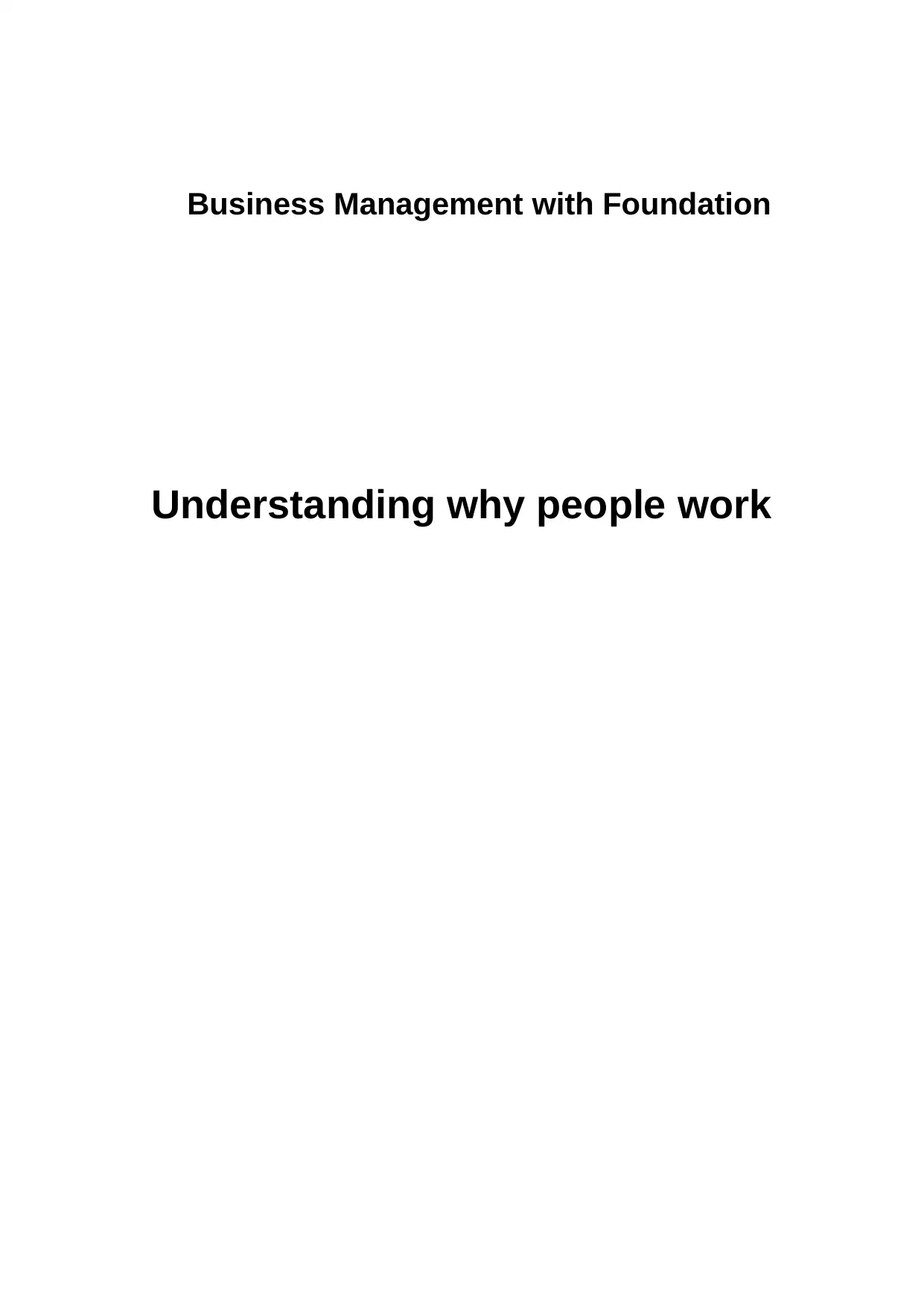
Business Management with Foundation
Understanding why people work
Understanding why people work
Secure Best Marks with AI Grader
Need help grading? Try our AI Grader for instant feedback on your assignments.
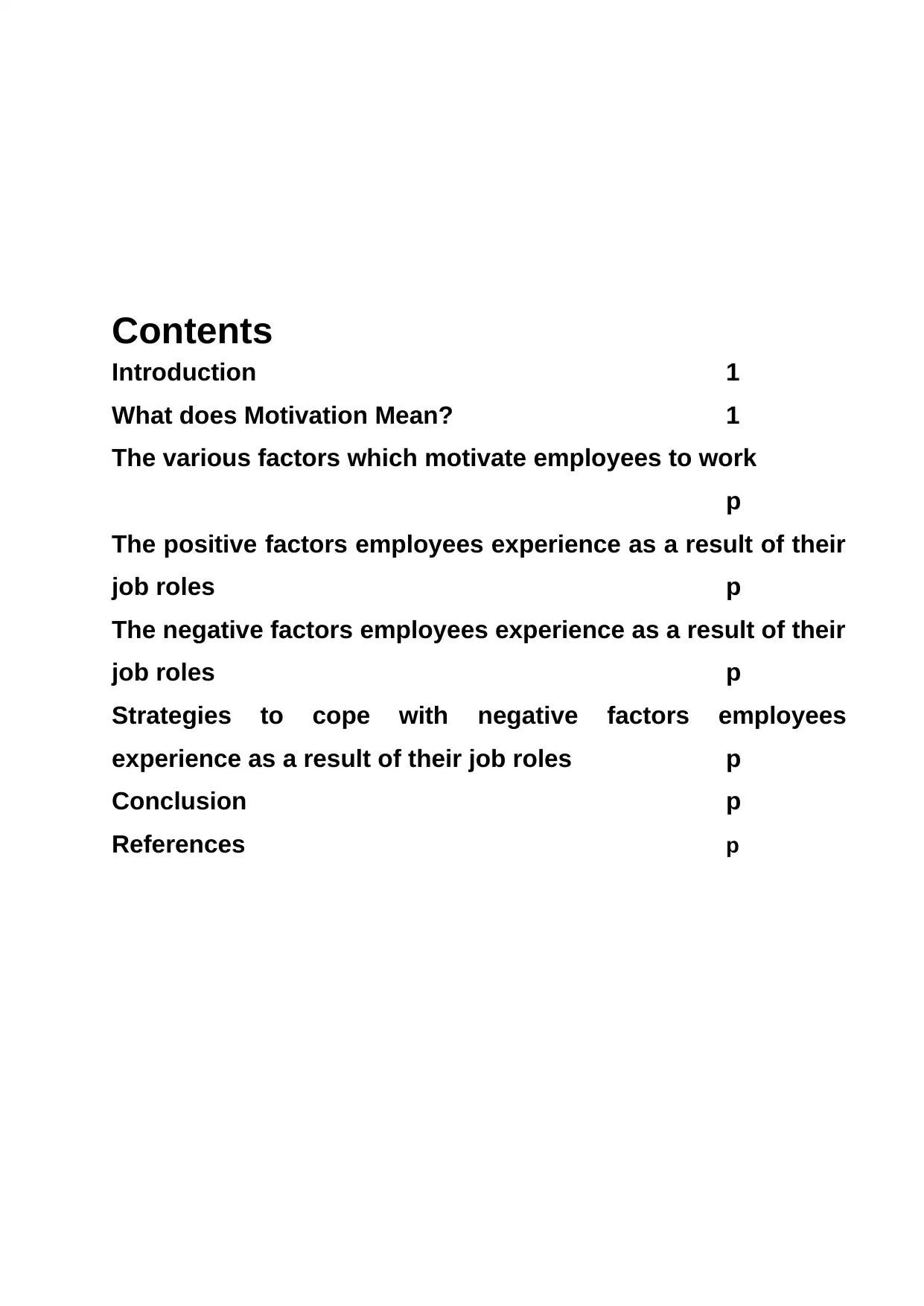
Contents
Introduction 1
What does Motivation Mean? 1
The various factors which motivate employees to work
p
The positive factors employees experience as a result of their
job roles p
The negative factors employees experience as a result of their
job roles p
Strategies to cope with negative factors employees
experience as a result of their job roles p
Conclusion p
References p
Introduction 1
What does Motivation Mean? 1
The various factors which motivate employees to work
p
The positive factors employees experience as a result of their
job roles p
The negative factors employees experience as a result of their
job roles p
Strategies to cope with negative factors employees
experience as a result of their job roles p
Conclusion p
References p

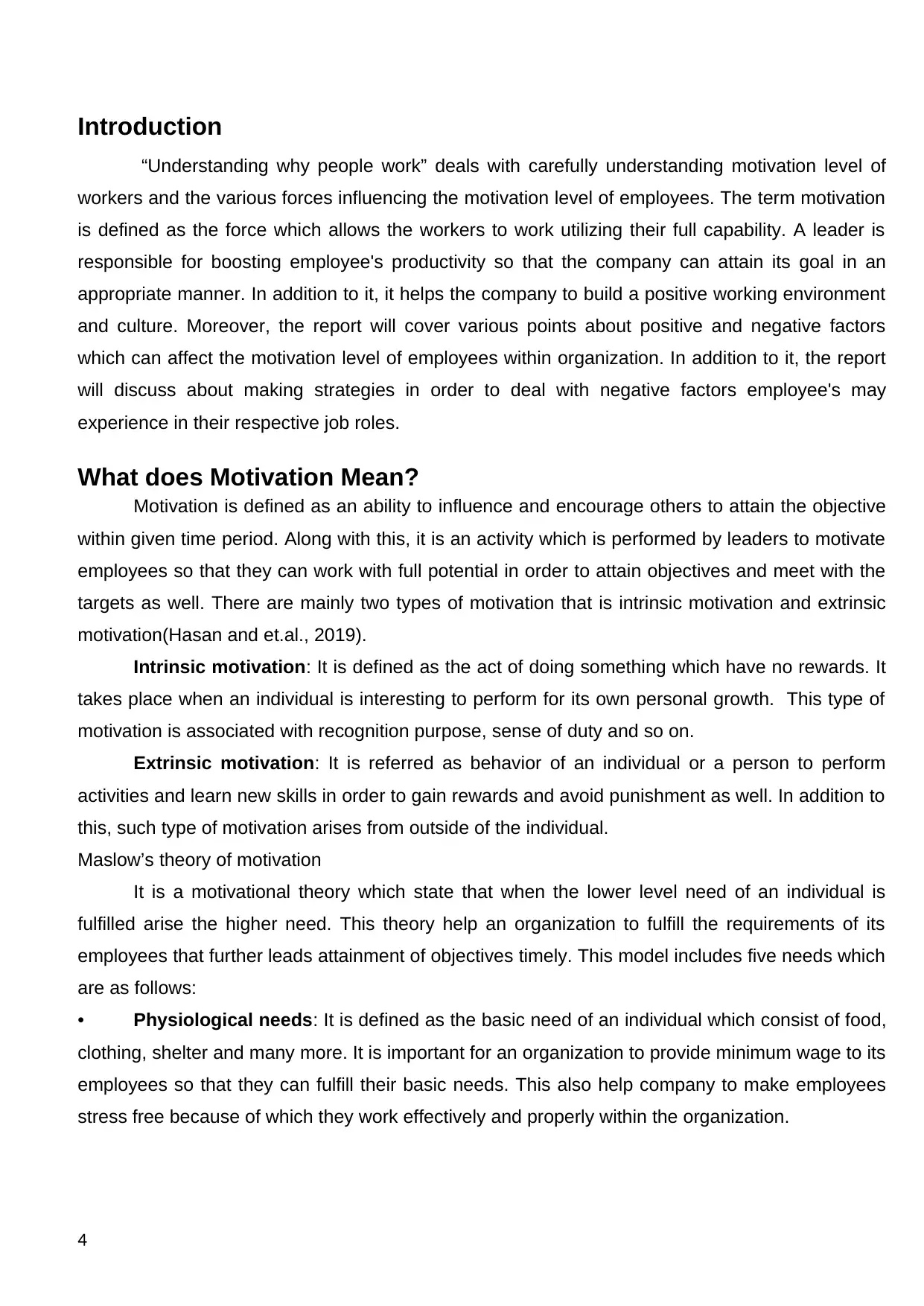
Introduction
“Understanding why people work” deals with carefully understanding motivation level of
workers and the various forces influencing the motivation level of employees. The term motivation
is defined as the force which allows the workers to work utilizing their full capability. A leader is
responsible for boosting employee's productivity so that the company can attain its goal in an
appropriate manner. In addition to it, it helps the company to build a positive working environment
and culture. Moreover, the report will cover various points about positive and negative factors
which can affect the motivation level of employees within organization. In addition to it, the report
will discuss about making strategies in order to deal with negative factors employee's may
experience in their respective job roles.
What does Motivation Mean?
Motivation is defined as an ability to influence and encourage others to attain the objective
within given time period. Along with this, it is an activity which is performed by leaders to motivate
employees so that they can work with full potential in order to attain objectives and meet with the
targets as well. There are mainly two types of motivation that is intrinsic motivation and extrinsic
motivation(Hasan and et.al., 2019).
Intrinsic motivation: It is defined as the act of doing something which have no rewards. It
takes place when an individual is interesting to perform for its own personal growth. This type of
motivation is associated with recognition purpose, sense of duty and so on.
Extrinsic motivation: It is referred as behavior of an individual or a person to perform
activities and learn new skills in order to gain rewards and avoid punishment as well. In addition to
this, such type of motivation arises from outside of the individual.
Maslow’s theory of motivation
It is a motivational theory which state that when the lower level need of an individual is
fulfilled arise the higher need. This theory help an organization to fulfill the requirements of its
employees that further leads attainment of objectives timely. This model includes five needs which
are as follows:
• Physiological needs: It is defined as the basic need of an individual which consist of food,
clothing, shelter and many more. It is important for an organization to provide minimum wage to its
employees so that they can fulfill their basic needs. This also help company to make employees
stress free because of which they work effectively and properly within the organization.
4
“Understanding why people work” deals with carefully understanding motivation level of
workers and the various forces influencing the motivation level of employees. The term motivation
is defined as the force which allows the workers to work utilizing their full capability. A leader is
responsible for boosting employee's productivity so that the company can attain its goal in an
appropriate manner. In addition to it, it helps the company to build a positive working environment
and culture. Moreover, the report will cover various points about positive and negative factors
which can affect the motivation level of employees within organization. In addition to it, the report
will discuss about making strategies in order to deal with negative factors employee's may
experience in their respective job roles.
What does Motivation Mean?
Motivation is defined as an ability to influence and encourage others to attain the objective
within given time period. Along with this, it is an activity which is performed by leaders to motivate
employees so that they can work with full potential in order to attain objectives and meet with the
targets as well. There are mainly two types of motivation that is intrinsic motivation and extrinsic
motivation(Hasan and et.al., 2019).
Intrinsic motivation: It is defined as the act of doing something which have no rewards. It
takes place when an individual is interesting to perform for its own personal growth. This type of
motivation is associated with recognition purpose, sense of duty and so on.
Extrinsic motivation: It is referred as behavior of an individual or a person to perform
activities and learn new skills in order to gain rewards and avoid punishment as well. In addition to
this, such type of motivation arises from outside of the individual.
Maslow’s theory of motivation
It is a motivational theory which state that when the lower level need of an individual is
fulfilled arise the higher need. This theory help an organization to fulfill the requirements of its
employees that further leads attainment of objectives timely. This model includes five needs which
are as follows:
• Physiological needs: It is defined as the basic need of an individual which consist of food,
clothing, shelter and many more. It is important for an organization to provide minimum wage to its
employees so that they can fulfill their basic needs. This also help company to make employees
stress free because of which they work effectively and properly within the organization.
4
Secure Best Marks with AI Grader
Need help grading? Try our AI Grader for instant feedback on your assignments.
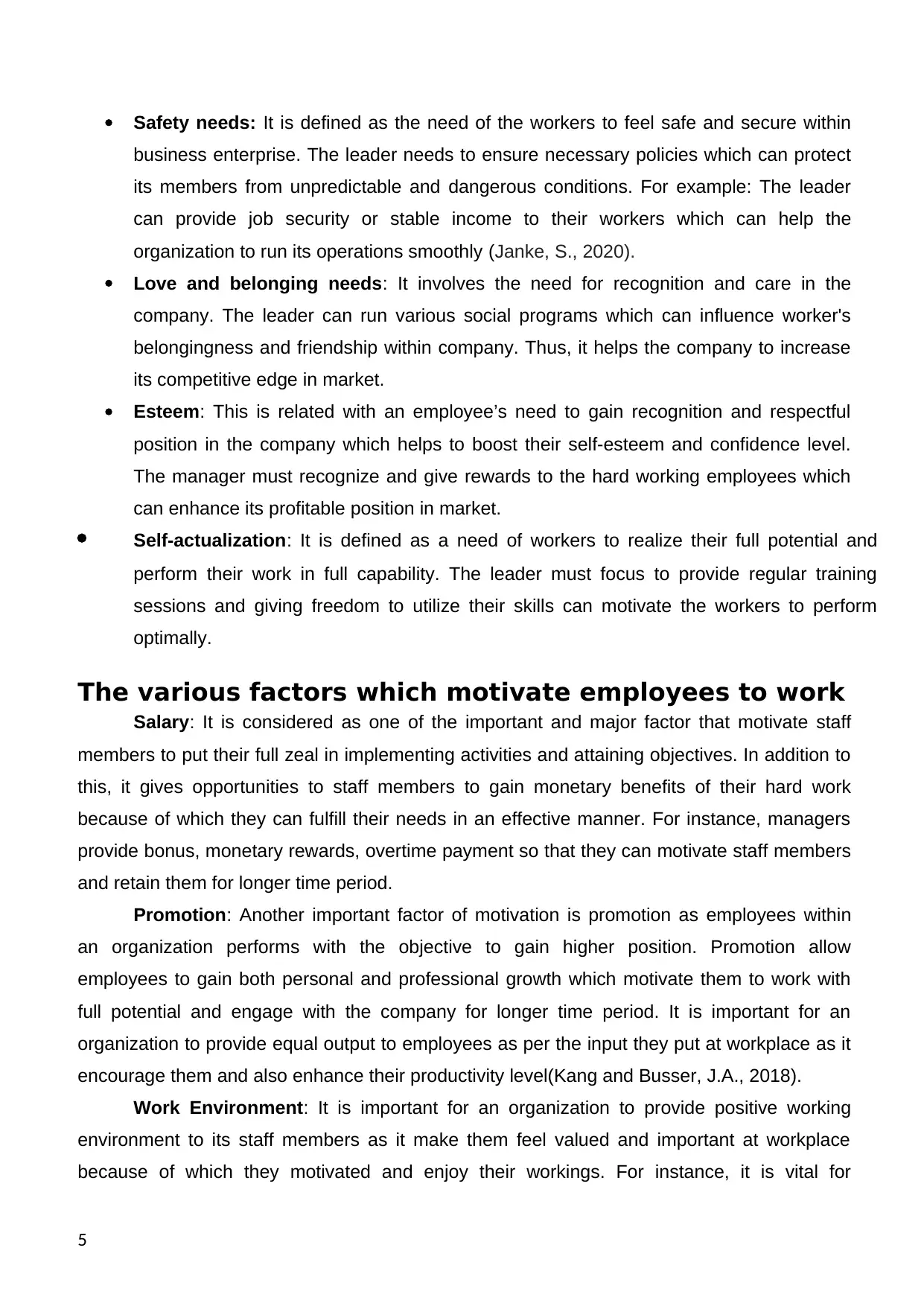
Safety needs: It is defined as the need of the workers to feel safe and secure within
business enterprise. The leader needs to ensure necessary policies which can protect
its members from unpredictable and dangerous conditions. For example: The leader
can provide job security or stable income to their workers which can help the
organization to run its operations smoothly (Janke, S., 2020).
Love and belonging needs: It involves the need for recognition and care in the
company. The leader can run various social programs which can influence worker's
belongingness and friendship within company. Thus, it helps the company to increase
its competitive edge in market.
Esteem: This is related with an employee’s need to gain recognition and respectful
position in the company which helps to boost their self-esteem and confidence level.
The manager must recognize and give rewards to the hard working employees which
can enhance its profitable position in market.
Self-actualization: It is defined as a need of workers to realize their full potential and
perform their work in full capability. The leader must focus to provide regular training
sessions and giving freedom to utilize their skills can motivate the workers to perform
optimally.
The various factors which motivate employees to work
Salary: It is considered as one of the important and major factor that motivate staff
members to put their full zeal in implementing activities and attaining objectives. In addition to
this, it gives opportunities to staff members to gain monetary benefits of their hard work
because of which they can fulfill their needs in an effective manner. For instance, managers
provide bonus, monetary rewards, overtime payment so that they can motivate staff members
and retain them for longer time period.
Promotion: Another important factor of motivation is promotion as employees within
an organization performs with the objective to gain higher position. Promotion allow
employees to gain both personal and professional growth which motivate them to work with
full potential and engage with the company for longer time period. It is important for an
organization to provide equal output to employees as per the input they put at workplace as it
encourage them and also enhance their productivity level(Kang and Busser, J.A., 2018).
Work Environment: It is important for an organization to provide positive working
environment to its staff members as it make them feel valued and important at workplace
because of which they motivated and enjoy their workings. For instance, it is vital for
5
business enterprise. The leader needs to ensure necessary policies which can protect
its members from unpredictable and dangerous conditions. For example: The leader
can provide job security or stable income to their workers which can help the
organization to run its operations smoothly (Janke, S., 2020).
Love and belonging needs: It involves the need for recognition and care in the
company. The leader can run various social programs which can influence worker's
belongingness and friendship within company. Thus, it helps the company to increase
its competitive edge in market.
Esteem: This is related with an employee’s need to gain recognition and respectful
position in the company which helps to boost their self-esteem and confidence level.
The manager must recognize and give rewards to the hard working employees which
can enhance its profitable position in market.
Self-actualization: It is defined as a need of workers to realize their full potential and
perform their work in full capability. The leader must focus to provide regular training
sessions and giving freedom to utilize their skills can motivate the workers to perform
optimally.
The various factors which motivate employees to work
Salary: It is considered as one of the important and major factor that motivate staff
members to put their full zeal in implementing activities and attaining objectives. In addition to
this, it gives opportunities to staff members to gain monetary benefits of their hard work
because of which they can fulfill their needs in an effective manner. For instance, managers
provide bonus, monetary rewards, overtime payment so that they can motivate staff members
and retain them for longer time period.
Promotion: Another important factor of motivation is promotion as employees within
an organization performs with the objective to gain higher position. Promotion allow
employees to gain both personal and professional growth which motivate them to work with
full potential and engage with the company for longer time period. It is important for an
organization to provide equal output to employees as per the input they put at workplace as it
encourage them and also enhance their productivity level(Kang and Busser, J.A., 2018).
Work Environment: It is important for an organization to provide positive working
environment to its staff members as it make them feel valued and important at workplace
because of which they motivated and enjoy their workings. For instance, it is vital for
5
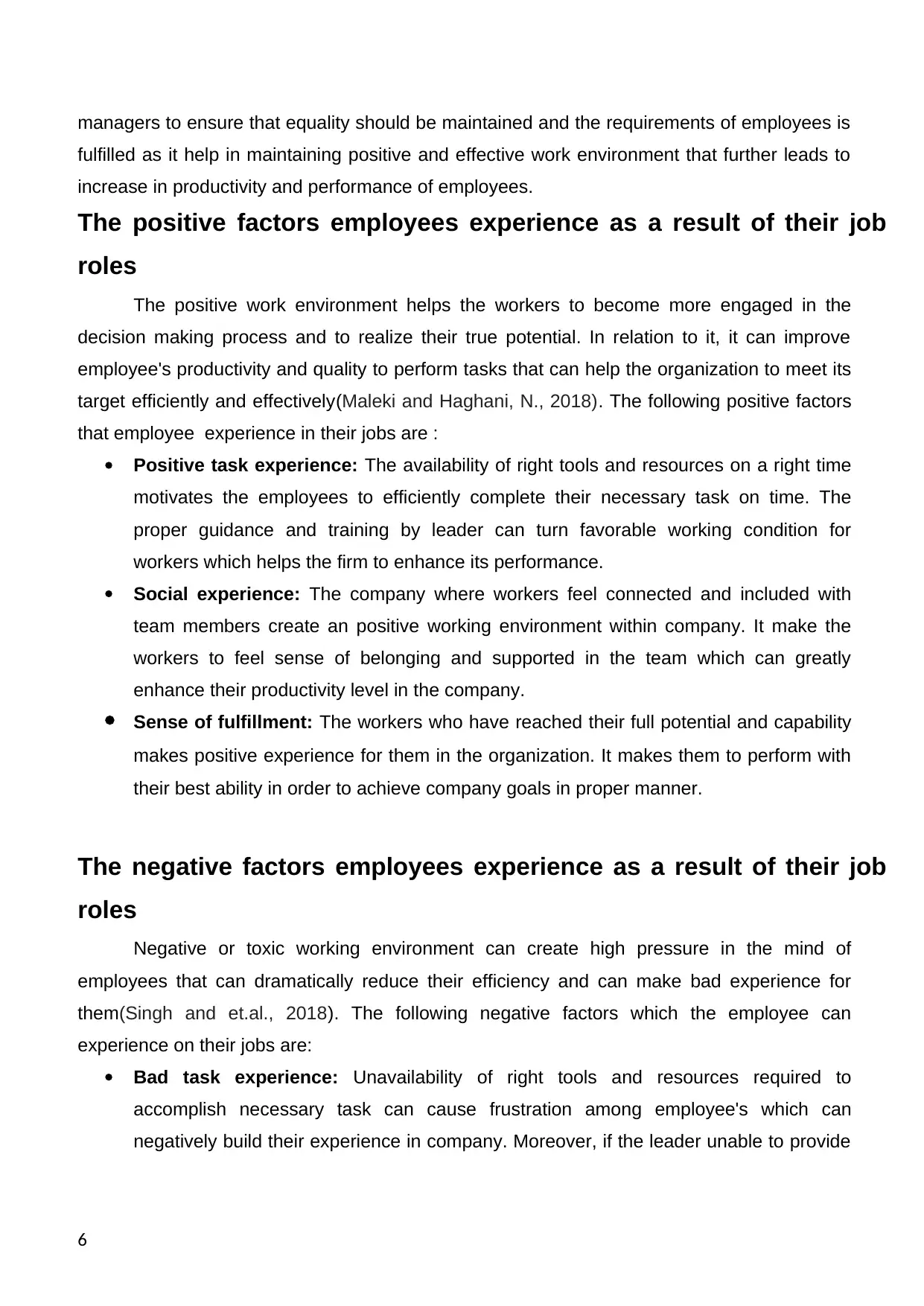
managers to ensure that equality should be maintained and the requirements of employees is
fulfilled as it help in maintaining positive and effective work environment that further leads to
increase in productivity and performance of employees.
The positive factors employees experience as a result of their job
roles
The positive work environment helps the workers to become more engaged in the
decision making process and to realize their true potential. In relation to it, it can improve
employee's productivity and quality to perform tasks that can help the organization to meet its
target efficiently and effectively(Maleki and Haghani, N., 2018). The following positive factors
that employee experience in their jobs are :
Positive task experience: The availability of right tools and resources on a right time
motivates the employees to efficiently complete their necessary task on time. The
proper guidance and training by leader can turn favorable working condition for
workers which helps the firm to enhance its performance.
Social experience: The company where workers feel connected and included with
team members create an positive working environment within company. It make the
workers to feel sense of belonging and supported in the team which can greatly
enhance their productivity level in the company.
Sense of fulfillment: The workers who have reached their full potential and capability
makes positive experience for them in the organization. It makes them to perform with
their best ability in order to achieve company goals in proper manner.
The negative factors employees experience as a result of their job
roles
Negative or toxic working environment can create high pressure in the mind of
employees that can dramatically reduce their efficiency and can make bad experience for
them(Singh and et.al., 2018). The following negative factors which the employee can
experience on their jobs are:
Bad task experience: Unavailability of right tools and resources required to
accomplish necessary task can cause frustration among employee's which can
negatively build their experience in company. Moreover, if the leader unable to provide
6
fulfilled as it help in maintaining positive and effective work environment that further leads to
increase in productivity and performance of employees.
The positive factors employees experience as a result of their job
roles
The positive work environment helps the workers to become more engaged in the
decision making process and to realize their true potential. In relation to it, it can improve
employee's productivity and quality to perform tasks that can help the organization to meet its
target efficiently and effectively(Maleki and Haghani, N., 2018). The following positive factors
that employee experience in their jobs are :
Positive task experience: The availability of right tools and resources on a right time
motivates the employees to efficiently complete their necessary task on time. The
proper guidance and training by leader can turn favorable working condition for
workers which helps the firm to enhance its performance.
Social experience: The company where workers feel connected and included with
team members create an positive working environment within company. It make the
workers to feel sense of belonging and supported in the team which can greatly
enhance their productivity level in the company.
Sense of fulfillment: The workers who have reached their full potential and capability
makes positive experience for them in the organization. It makes them to perform with
their best ability in order to achieve company goals in proper manner.
The negative factors employees experience as a result of their job
roles
Negative or toxic working environment can create high pressure in the mind of
employees that can dramatically reduce their efficiency and can make bad experience for
them(Singh and et.al., 2018). The following negative factors which the employee can
experience on their jobs are:
Bad task experience: Unavailability of right tools and resources required to
accomplish necessary task can cause frustration among employee's which can
negatively build their experience in company. Moreover, if the leader unable to provide
6
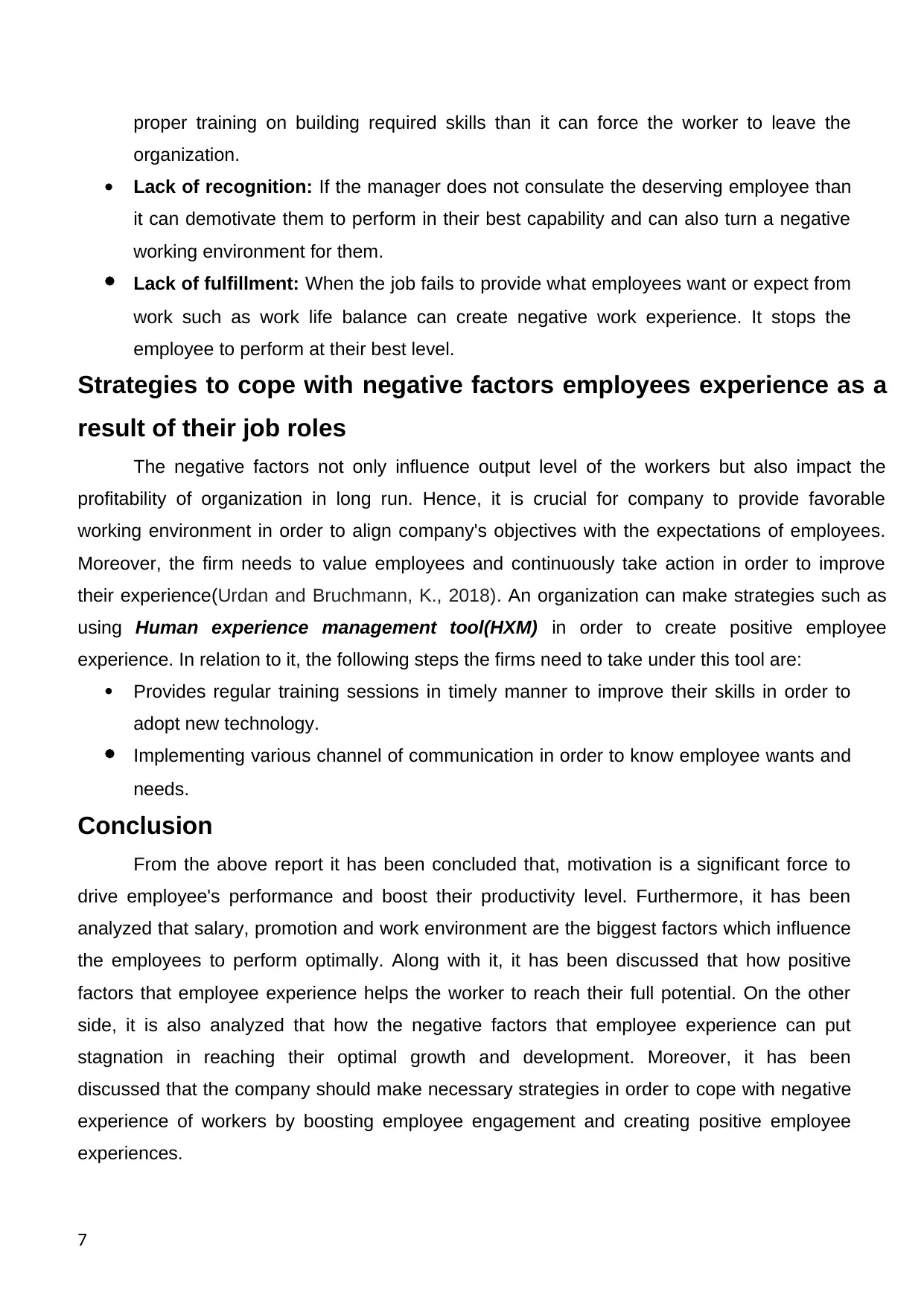
proper training on building required skills than it can force the worker to leave the
organization.
Lack of recognition: If the manager does not consulate the deserving employee than
it can demotivate them to perform in their best capability and can also turn a negative
working environment for them.
Lack of fulfillment: When the job fails to provide what employees want or expect from
work such as work life balance can create negative work experience. It stops the
employee to perform at their best level.
Strategies to cope with negative factors employees experience as a
result of their job roles
The negative factors not only influence output level of the workers but also impact the
profitability of organization in long run. Hence, it is crucial for company to provide favorable
working environment in order to align company's objectives with the expectations of employees.
Moreover, the firm needs to value employees and continuously take action in order to improve
their experience(Urdan and Bruchmann, K., 2018). An organization can make strategies such as
using Human experience management tool(HXM) in order to create positive employee
experience. In relation to it, the following steps the firms need to take under this tool are:
Provides regular training sessions in timely manner to improve their skills in order to
adopt new technology.
Implementing various channel of communication in order to know employee wants and
needs.
Conclusion
From the above report it has been concluded that, motivation is a significant force to
drive employee's performance and boost their productivity level. Furthermore, it has been
analyzed that salary, promotion and work environment are the biggest factors which influence
the employees to perform optimally. Along with it, it has been discussed that how positive
factors that employee experience helps the worker to reach their full potential. On the other
side, it is also analyzed that how the negative factors that employee experience can put
stagnation in reaching their optimal growth and development. Moreover, it has been
discussed that the company should make necessary strategies in order to cope with negative
experience of workers by boosting employee engagement and creating positive employee
experiences.
7
organization.
Lack of recognition: If the manager does not consulate the deserving employee than
it can demotivate them to perform in their best capability and can also turn a negative
working environment for them.
Lack of fulfillment: When the job fails to provide what employees want or expect from
work such as work life balance can create negative work experience. It stops the
employee to perform at their best level.
Strategies to cope with negative factors employees experience as a
result of their job roles
The negative factors not only influence output level of the workers but also impact the
profitability of organization in long run. Hence, it is crucial for company to provide favorable
working environment in order to align company's objectives with the expectations of employees.
Moreover, the firm needs to value employees and continuously take action in order to improve
their experience(Urdan and Bruchmann, K., 2018). An organization can make strategies such as
using Human experience management tool(HXM) in order to create positive employee
experience. In relation to it, the following steps the firms need to take under this tool are:
Provides regular training sessions in timely manner to improve their skills in order to
adopt new technology.
Implementing various channel of communication in order to know employee wants and
needs.
Conclusion
From the above report it has been concluded that, motivation is a significant force to
drive employee's performance and boost their productivity level. Furthermore, it has been
analyzed that salary, promotion and work environment are the biggest factors which influence
the employees to perform optimally. Along with it, it has been discussed that how positive
factors that employee experience helps the worker to reach their full potential. On the other
side, it is also analyzed that how the negative factors that employee experience can put
stagnation in reaching their optimal growth and development. Moreover, it has been
discussed that the company should make necessary strategies in order to cope with negative
experience of workers by boosting employee engagement and creating positive employee
experiences.
7
Paraphrase This Document
Need a fresh take? Get an instant paraphrase of this document with our AI Paraphraser
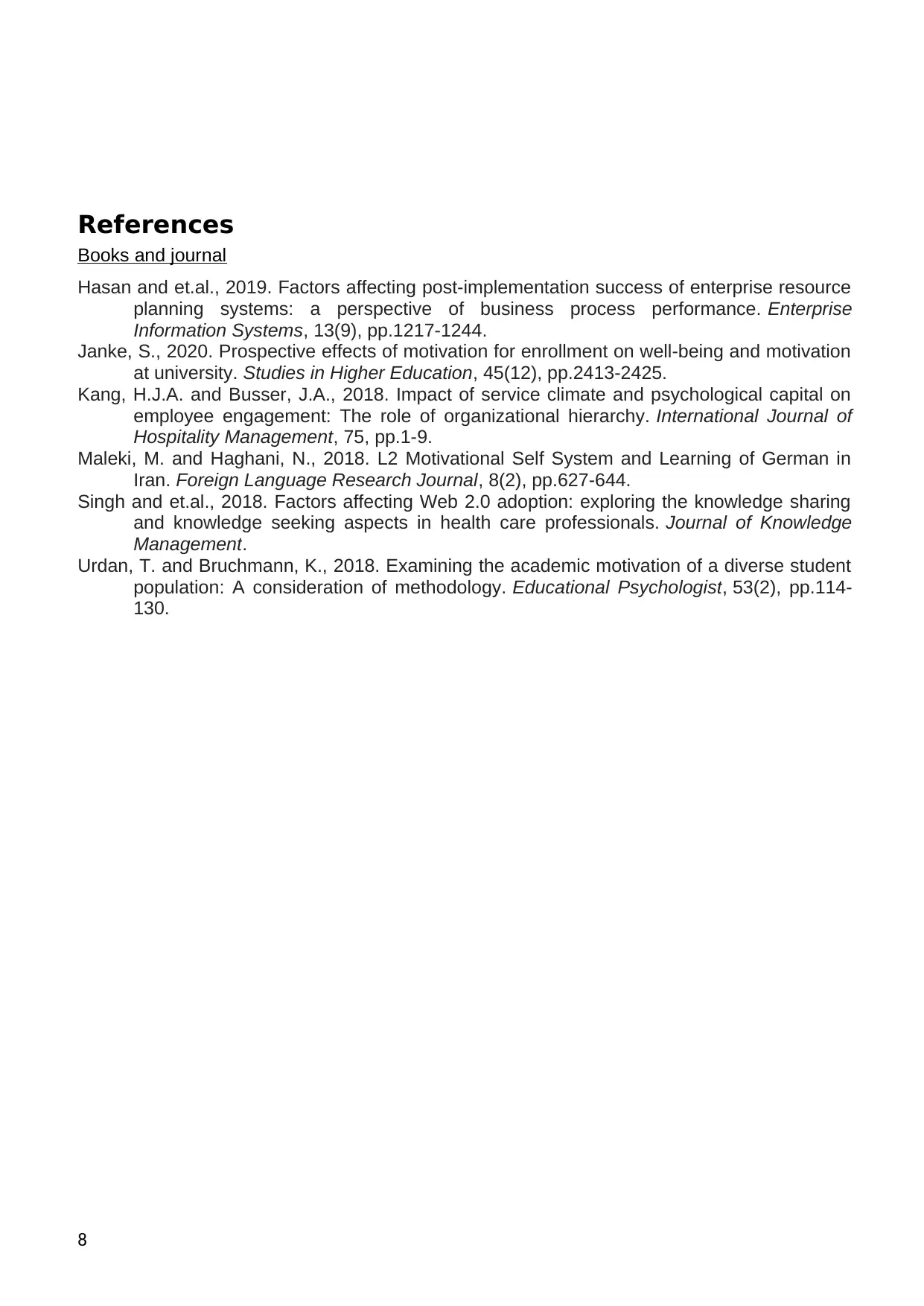
References
Books and journal
Hasan and et.al., 2019. Factors affecting post-implementation success of enterprise resource
planning systems: a perspective of business process performance. Enterprise
Information Systems, 13(9), pp.1217-1244.
Janke, S., 2020. Prospective effects of motivation for enrollment on well-being and motivation
at university. Studies in Higher Education, 45(12), pp.2413-2425.
Kang, H.J.A. and Busser, J.A., 2018. Impact of service climate and psychological capital on
employee engagement: The role of organizational hierarchy. International Journal of
Hospitality Management, 75, pp.1-9.
Maleki, M. and Haghani, N., 2018. L2 Motivational Self System and Learning of German in
Iran. Foreign Language Research Journal, 8(2), pp.627-644.
Singh and et.al., 2018. Factors affecting Web 2.0 adoption: exploring the knowledge sharing
and knowledge seeking aspects in health care professionals. Journal of Knowledge
Management.
Urdan, T. and Bruchmann, K., 2018. Examining the academic motivation of a diverse student
population: A consideration of methodology. Educational Psychologist, 53(2), pp.114-
130.
8
Books and journal
Hasan and et.al., 2019. Factors affecting post-implementation success of enterprise resource
planning systems: a perspective of business process performance. Enterprise
Information Systems, 13(9), pp.1217-1244.
Janke, S., 2020. Prospective effects of motivation for enrollment on well-being and motivation
at university. Studies in Higher Education, 45(12), pp.2413-2425.
Kang, H.J.A. and Busser, J.A., 2018. Impact of service climate and psychological capital on
employee engagement: The role of organizational hierarchy. International Journal of
Hospitality Management, 75, pp.1-9.
Maleki, M. and Haghani, N., 2018. L2 Motivational Self System and Learning of German in
Iran. Foreign Language Research Journal, 8(2), pp.627-644.
Singh and et.al., 2018. Factors affecting Web 2.0 adoption: exploring the knowledge sharing
and knowledge seeking aspects in health care professionals. Journal of Knowledge
Management.
Urdan, T. and Bruchmann, K., 2018. Examining the academic motivation of a diverse student
population: A consideration of methodology. Educational Psychologist, 53(2), pp.114-
130.
8
1 out of 8
Related Documents
Your All-in-One AI-Powered Toolkit for Academic Success.
+13062052269
info@desklib.com
Available 24*7 on WhatsApp / Email
![[object Object]](/_next/static/media/star-bottom.7253800d.svg)
Unlock your academic potential
© 2024 | Zucol Services PVT LTD | All rights reserved.


